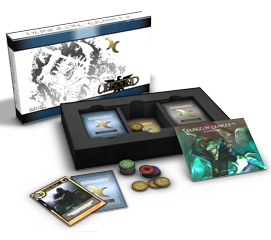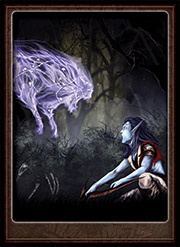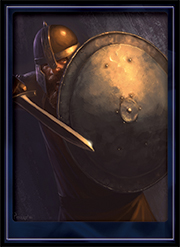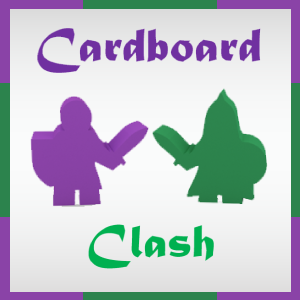As part of my preparation for solo month, I put out a call for designers to contact me if they had a soloable game. A few of them also offered to be interviewed, and the first of those to be featured this month is Jey Legarie, who contacted me about his game, Dungeon Crawler. Prior to his contact, I knew nothing about the game. I still haven’t played it myself, but after interviewing Jey and looking into the game on their website, I have become very interested to try it out in the future!

**Note: anything in italics is added by me to add to, or expand on, something Jey mentions.
1. There is a rich lore behind the game you’ve created. Let’s start by having you share a little bit of the world players will immerse themselves in when they pick up Dungeon Crawler.
Dungeon Crawler™ ECG is based in the world of Ara, a fantasy rich environment which focuses on the small fledgling kingdom of Keldorna due to a bit of luck as they face a halted invading Southern Empire. Adventure is afoot as borders and alliances shift.
(Note: You can learn a whole lot more at this link: http://www.dungeoncrawler.com/universe/index.html)
2. The card game was initially a collectable game, but it is now modified into fixed packs (Expandable Card Game). What prompted that change in approach?

While designing DC ECG (it was my first game), I was only really familiar with my own experiences with gaming and CCG’s didn’t have a bad name where I was from. Once I hit the market, it was not well received, suffice it to say that customer pressure and some required fixes because of the printers were the reasoning and opportunity in that order.
3. What can a solo gamer expect from their experience in the Unbound Starter? In other words, how much replayable content is in there before a player will need to expand?
With DC ECG we’ve had many players just stick with the starters, and it provides literally hundreds of different experiences. The base of the game is to build encounters from the Dungeon deck based on Encounter Limits, which means each encounter is very different, while your response is done with cards from the randomised Crawler deck resulting in how you can respond to the encounter being different from hand to hand. The Quests can make it difficult or easy, and the game’s flexible encounter limits and adventurers can also change the flavour in surprising ways. We demo’d this game for 2 years by shuffling the decks and just playing the game before we came up with the walk through for our demo.
(There is a whole section on Scenarios on their website, which has a promising amount of content for a solo gamer! http://www.dungeoncrawler.com/ecg/campaigns.html)
 4. What does each expansion add to the solo gameplay? Is there an order you would recommend they follow?
4. What does each expansion add to the solo gameplay? Is there an order you would recommend they follow?
No order is necessary for collecting the Delve Packs, they are after-all an extension of the base Unbound set. I would recommend collecting them in order of interest as they do have a certain flavour for each such as; traps (Keldorna), undead (Stonehold), poison (Sylvan), big monsters (Barren Mountains) or new land (Outlands). They do offer unique Adventurers (Heroes), Quests, and will fill out your sets, but also offer a few unique cards not found in other packs. The Expansion packs are more difficult and all new material.
5. Let’s shift gears here and talk about developing the game. What challenges did you encounter in designing the solo gameplay for Dungeon Crawler?

Originally the game was too complex, although it still has a great deal of complexity to it, it is most more manageable. Another issues was artificial scaling. I didn’t want to have a game that overwhelmed the players artificially, instead I designed it so that most items, spells or anything in play reset each round to prevent that artificial feel.
6. What makes Dungeon Crawler stand out from the crowded realm of dungeon crawl board games?
That’s truly a tough question to answer as there are so many. Card games really lend themselves more to the realm of imagination, and DC ECG really does this well. It’s a quick set up, with options to play fast games, while also letting you build Dungeon decks to be as difficult as you like, and Crawler decks to be as catch-all or specialist as you like.
 7. Finally, where can people go to learn more about the game, follow you on any further developments, and to purchase their copy of Dungeon Crawler and expansions?
7. Finally, where can people go to learn more about the game, follow you on any further developments, and to purchase their copy of Dungeon Crawler and expansions?


 I’m a sucker for anything Arthurian, so that immediately drew me in for both this version and my previously-reviewed Avalon version. I really enjoyed the artwork and the names of some of the cards. While there were generic names for a few things (which do fit in thematically), there were also a lot of recognizable characters and places from the Arthurian lore. Any fan of King Arthur will enjoy this aspect of the game, although the artwork can be enjoyed by those who know nothing of King Arthur. This version also contained many more of the “traditional” characters from Arthurian lore: the ones that come first to mind when you mention King Arthur.
I’m a sucker for anything Arthurian, so that immediately drew me in for both this version and my previously-reviewed Avalon version. I really enjoyed the artwork and the names of some of the cards. While there were generic names for a few things (which do fit in thematically), there were also a lot of recognizable characters and places from the Arthurian lore. Any fan of King Arthur will enjoy this aspect of the game, although the artwork can be enjoyed by those who know nothing of King Arthur. This version also contained many more of the “traditional” characters from Arthurian lore: the ones that come first to mind when you mention King Arthur.



 While I received a prototype, so final quality may vary, the cards were noticeable getting some wear around the edges after only a few plays. This is something that many gamers are going to want to sleeve to preserve the quality, but I don’t think the box it comes in will hold the sleeved cards. Both of those could easily be fixed by the time this releases.
While I received a prototype, so final quality may vary, the cards were noticeable getting some wear around the edges after only a few plays. This is something that many gamers are going to want to sleeve to preserve the quality, but I don’t think the box it comes in will hold the sleeved cards. Both of those could easily be fixed by the time this releases. If you’re looking for a game that does something new or groundbreaking, this isn’t it. This is a great retheming and addition to a traditional game, but it won’t provide an experience that isn’t similar to other games (Crazy Eights, Fluxx, Uno, and more). It doesn’t necessarily need to, as this game is fun the way it is, but not everyone will want a game that is similar to something they already have.
If you’re looking for a game that does something new or groundbreaking, this isn’t it. This is a great retheming and addition to a traditional game, but it won’t provide an experience that isn’t similar to other games (Crazy Eights, Fluxx, Uno, and more). It doesn’t necessarily need to, as this game is fun the way it is, but not everyone will want a game that is similar to something they already have.